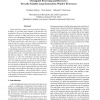Free Online Productivity Tools
i2Speak
i2Symbol
i2OCR
iTex2Img
iWeb2Print
iWeb2Shot
i2Type
iPdf2Split
iPdf2Merge
i2Bopomofo
i2Arabic
i2Style
i2Image
i2PDF
iLatex2Rtf
Sci2ools
MICRO
2003
IEEE
2003
IEEE
Checkpoint Processing and Recovery: Towards Scalable Large Instruction Window Processors
Large instruction window processors achieve high performance by exposing large amounts of instruction level parallelism. However, accessing large hardware structures typically required to buffer and process such instruction window sizes significantly degrade the cycle time. This paper proposes a novel Checkpoint Processing and Recovery (CPR) microarchitecture, and shows how to implement a large instruction window processor without requiring large structures thus permitting a high clock frequency. We focus on four critical aspects of a microarchitecture: 1) scheduling instructions, 2) recovering from branch mispredicts, 3) buffering a large number of stores and forwarding data from stores to any dependent load, and 4) reclaiming physical registers. While scheduling window size is important, we show the performance of large instruction windows to be more sensitive to the other three design issues. Our CPR proposal incorporates novel microarchitectural schemes for addressing these desig...
Hardware | Instruction Window Processor | Instruction Windows | Large Instruction Windows | MICRO 2003 |
| Added | 05 Jul 2010 |
| Updated | 05 Jul 2010 |
| Type | Conference |
| Year | 2003 |
| Where | MICRO |
| Authors | Haitham Akkary, Ravi Rajwar, Srikanth T. Srinivasan |
Comments (0)

